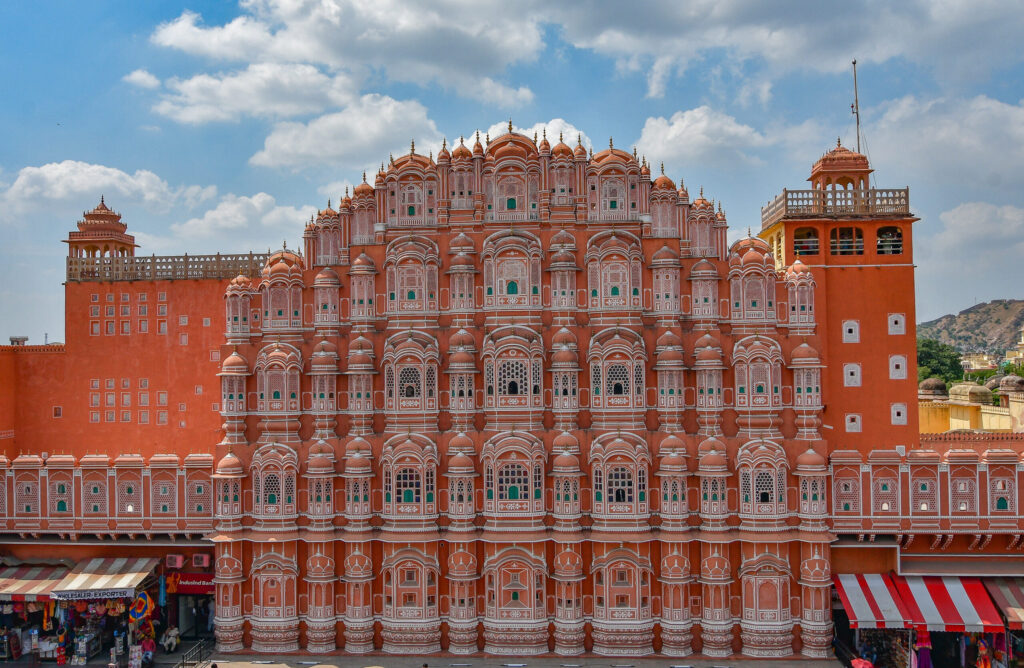Nestled in the heart of Jaipur, Rajasthan, Hawa Mahal Jaipur, or the “Palace of Winds,” stands as a stunning testament to the architectural brilliance of the Rajput era. Built in 1799 by Maharaja Sawai Jai Singh II, this unique structure is not just a visual marvel but also a fascinating glimpse into the lifestyle of royal women in a bygone era.

A Brief History
The Hawa Mahal was designed by the talented architect Lal Chand Ustad, who created this five-story palace primarily for the women of the royal household. The design was intended to allow them to observe street festivities and daily life without being seen, adhering to the strict customs of purdah (the practice of seclusion). The palace’s intricate latticework and numerous windows provided a means of ventilation, allowing cool breezes to flow through—hence the name “Palace of Winds.”
Architectural Marvel
The Hawa Mahal is strikingly different from typical palaces. Its façade, adorned with 953 small windows, known as jharokhas, is a sight to behold. Made from red and pink sandstone, the palace glows in the sunlight, creating a mesmerizing spectacle. The unique honeycomb structure not only serves aesthetic purposes but also contributes to its cooling system, making it a perfect retreat during the scorching summers of Rajasthan.
The palace is an impressive example of Rajput architecture, blending Islamic and Hindu styles. The delicate carvings and floral motifs showcase the artistry of local craftsmen. Each window is designed with intricate latticework, allowing the royal women to enjoy the view while maintaining their privacy. The overall structure resembles a crown, a nod to the royal heritage of Jaipur.
Inside the Palace
Entering Hawa Mahal, visitors find themselves in a series of courtyards and chambers. The interior is surprisingly simple compared to the grandeur of the exterior, but it offers a glimpse into the daily lives of the women who lived there. The rooms are adorned with vibrant frescoes, and the cool breeze flowing through the windows makes the atmosphere refreshing.
One of the main attractions inside is the central courtyard, which is surrounded by corridors leading to various rooms. As you stroll through, you can appreciate the blend of functionality and aesthetics that define the palace. The cool shade and soothing air make it a welcome escape from the heat outside.

The View from the Top
Climbing to the upper levels of Hawa Mahal offers visitors a panoramic view of the bustling city of Jaipur. The sight of colorful markets, majestic forts, and the Aravalli hills in the distance is truly breathtaking. The best time to visit is during sunrise or sunset when the golden light bathes the palace, creating an ethereal ambiance.

Cultural Significance
Hawa Mahal is not just a historical monument; it plays a vital role in the cultural fabric of Jaipur. It is a symbol of the city’s rich heritage and is often featured in postcards and travel brochures. The palace attracts thousands of tourists each year, making it one of Jaipur’s most popular landmarks. Its proximity to other significant sites like the City Palace and Jantar Mantar makes it an essential part of the city’s historical circuit.
Visiting Tips
If you plan to visit Hawa Mahal, here are some tips to enhance your experience:
- Timing: The best time to visit is early morning or late afternoon to avoid the midday heat and enjoy the beautiful lighting for photography.
- Photography: Don’t forget your camera! The intricate details of the architecture and the surrounding landscapes offer fantastic photo opportunities.
- Guided Tours: Consider hiring a local guide who can share stories and historical insights about the palace, making your visit more enriching.
- Explore Nearby Attractions: After visiting Hawa Mahal, take time to explore other nearby attractions, such as the City Palace and Jantar Mantar, to fully immerse yourself in Jaipur’s heritage.
- Local Cuisine: Treat yourself to some local Rajasthani cuisine at nearby restaurants to complete your cultural experience.
Conclusion
Hawa Mahal Jaipur is more than just an architectural wonder; it is a portal to the past, offering visitors a glimpse into the royal lifestyle of its time. Its beauty and historical significance continue to captivate the hearts of all who visit. Whether you are an architecture enthusiast, a history buff, or simply a curious traveler, the Palace of Winds promises an unforgettable experience. So, next time you find yourself in Jaipur, be sure to unveil the magic of Hawa Mahal.

